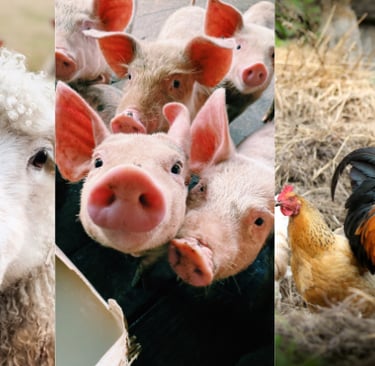Essential Tips for Raising Livestock on Your Small Homestead
When it comes to raising livestock on a small homestead, the first and perhaps most crucial step is selecting the right animals.
BACKYARD LIVESTOCK


Getting Started: Choosing the Right Livestock for Your Homestead
When it comes to raising livestock on a small homestead, the first and perhaps most crucial step is selecting the right animals. Factors such as the size of your property, the climate in your area, and your specific needs, such as meat, eggs, milk, or honey, are vital considerations in this decision-making process. By starting small and gradually expanding, you can ensure a more manageable and successful homesteading experience.
Chickens are often the top choice for many beginners. They are relatively low-maintenance, adapt well to various climates, and require less space compared to larger livestock. They provide a steady supply of fresh eggs and, depending on the breed, can also serve as a source of meat. Chickens can be a great starting point as they give you a feel for managing livestock without overwhelming you.
Goats are another excellent option, especially for those interested in producing their own milk. They thrive in diverse climates and can be kept in smaller spaces than cows. Goats are also known for their ability to clear weeds and brush, contributing to land management. Keep in mind that while they are generally hardy, they do require secure fencing to prevent escapes.
Rabbits are an ideal choice for homesteaders seeking a small, easy-to-care-for source of meat. They reproduce quickly and have relatively low space requirements. Rabbit hutches can be made with minimal expense, and the animals themselves are known for their efficient feed-to-meat conversion rates.
You might not immediately think of bees when considering livestock, but beekeeping offers a fascinating and rewarding venture. Bees require minimal space and provide honey, beeswax, and valuable pollination services for your garden. However, it is crucial to ensure that your local climate is suitable for beekeeping and that you are prepared for the initial costs and learning curve involved.
Personal experience has shown me that starting small is essential. I began my homesteading journey with a modest flock of chickens and slowly added goats and bees as I gained more confidence and expertise. This gradual approach allowed me to learn and adapt without becoming overwhelmed. Begin with one or two types of livestock, understand their needs, and once you feel comfortable, consider expanding your homestead incrementally.
Creating a Comfortable and Safe Environment for Your Animals
Building a sturdy, weather-appropriate shelter is fundamental to raising healthy livestock on your small homestead. Each type of livestock has its unique needs. For instance, poultry require well-ventilated coops with roosts and nesting boxes, while goats benefit from dry, elevated shelters that protect against wind and rain. Ensure these shelters are built using durable materials that can withstand local weather conditions, whether that means heavy snowfall, rain, or extreme heat.
Predator-proofing enclosures is another crucial aspect. Reinforce fencing with hardware cloth, especially for animals prone to predation, such as chickens and rabbits. Secure all gates and doors with sturdy latches and consider using electric fencing in areas with high predator pressure. This step helps ensure the safety and well-being of your livestock.
Proper ventilation cannot be overstated. Good airflow reduces humidity levels and prevents respiratory issues, which are common in poorly ventilated barns and coops. Installing windows, vents, or fans can vastly improve circulation, maintaining a healthier environment for your animals.
Clean and dry bedding is vital in maintaining livestock health. Regularly muck out stalls, coops, and pens to prevent the buildup of manure and moisture, which attracts pests and fosters disease. A consistent cleaning schedule also helps in monitoring the health of your animals by allowing you to notice any changes in their waste or behavior early on. Choosing appropriate bedding materials like straw, sawdust, or sand can aid in keeping the environment dry and comfortable.
Lastly, creating a stimulating environment helps prevent boredom and associated behavioral issues. For chickens, providing perches, dust baths, and varied foraging opportunities can keep them engaged. Goats appreciate climbing structures and toys that encourage natural behaviors like jumping and head-butting. Enriching the habitat of your livestock not only improves their quality of life but also enhances their overall health and productivity.
Nutritional Needs and Feeding Practices
Meeting the nutritional needs of your livestock is critical to maintaining their overall health and productivity on a small homestead. Each type of livestock has specific dietary requirements that must be addressed to ensure their growth and wellbeing. For instance, ruminants like cows and goats require a diet high in roughage, such as hay and pasture, supplemented with grains to provide essential protein and energy. Poultry, on the other hand, thrive on a balanced feed comprising grains, protein-rich legumes, and necessary vitamins and minerals.
A balanced diet is fundamental to preventing nutritional deficiencies or excesses, which can lead to serious health issues. Overfeeding can result in obesity and metabolic disorders, while under-feeding can cause malnutrition and weakened immune systems. Therefore, it is imperative to monitor the portion sizes and feeding schedules meticulously. For optimal health, livestock typically benefit from consistent feeding schedules with two primary meals each day, supplemented with clean, fresh water available at all times. Water quality is often overlooked but is just as essential; contaminated water sources can lead to disease and decreased livestock productivity.
Sourcing quality feed is an integral component of effective livestock management. This can be achieved through reliable local suppliers who provide fresh and nutrient-rich feed or by growing your own feed if your homestead allows it. When purchasing feed, ensure it is free from contaminants and mold to prevent spoilage. Storing feed in a dry, cool place can further extend its shelf life and maintain its nutritional value.
Additionally, including extra vitamins and minerals in the diet can support specific health needs or compensate for any potential nutrient gaps. For example, calcium supplements can prevent deficiencies in laying hens, while salt licks can provide essential minerals for grazing animals. Regularly assessing the condition and behavior of your livestock can alert you to any dietary adjustments that may be necessary.
Finally, safe storage practices are crucial to prevent feed degradation. Keep feed in sealed containers to protect against pests and moisture. Implementing these feeding practices can vastly improve the health and productivity of your livestock, ensuring your small homestead thrives
Health and Veterinary Care
Maintaining optimal health for your livestock is of paramount importance on any small homestead. Effective animal husbandry involves not just addressing health issues but also proactively preventing them through regular veterinary care. Common health challenges such as respiratory infections, parasites, and digestive disorders can greatly impact the well-being of your animals and, consequently, your homestead’s productivity.
Regular health checks are the cornerstone of preventive care. These evaluations help in early detection of potential problems before they escalate. Vaccinations and deworming schedules should be strictly adhered to, as they play crucial roles in safeguarding your livestock against common diseases. For instance, vaccinations for clostridial diseases, rabies, and tetanus are often essential. Deworming, on the other hand, helps in controlling internal parasites that can severely affect growth and productivity.
Recognizing signs of illness or distress in your livestock is essential. Symptoms such as loss of appetite, abnormal discharge, lethargy, or changes in behavior should be closely monitored. Early intervention can significantly enhance recovery rates. Additionally, administering basic first aid, such as wound cleaning or isolating sick animals, can prevent the spread of disease and promote quicker healing.
Building a good relationship with a local veterinarian who specializes in livestock is invaluable. A vet can provide professional advice, timely diagnostics, and effective treatments tailored to your specific breeds and conditions. Connecting with a vet early on, even if your animals are currently healthy, ensures prompt and informed responses during health crises.
Many homesteaders have witnessed firsthand the positive impact of proactive veterinary care. For instance, routine checks and vaccinations have helped small livestock farmers avoid major outbreaks of diseases. Likewise, early treatment of minor ailments has prevented more severe health issues, keeping their animals healthy and thriving.
Breeding and Raising Young Stock
Breeding small livestock on your homestead begins with the careful selection of breeding pairs. When choosing breeding pairs, it is essential to consider genetics, health, and temperament to improve the quality and productivity of your stock. Assessing the lineage and performance of prospective breeders ensures that desirable traits are passed on to the offspring. Timing is also crucial; understanding the breeding seasons for various species can help optimize reproductive success.
Once mating occurs, the focus shifts to the care of pregnant animals. Proper nutrition is critical during pregnancy, as it supports both the mother and the developing young. Ensuring a diet rich in essential nutrients and minerals, along with adequate hydration, creates a healthy environment for gestation. It's advisable to monitor pregnant animals regularly, observing for signs of distress or complications early on.
As the birthing date approaches, preparation is key. This includes providing a clean, warm, and secure birthing area to reduce the stress on the mother and new offspring. Having basic supplies on hand, such as clean towels, disinfectants, and veterinary contact information, allows you to handle any complications promptly. Assisting in a calm and confident manner during the birthing process can make a significant difference to the outcome.
Post-birth care involves ensuring that newborn animals receive colostrum within the first few hours of life, which is vital for immunity and early health. Regular monitoring and gentle handling can foster a quick recovery and bonding with the mother. Transitioning to solid food should be gradual and based on the species' specific dietary needs, with careful oversight to prevent digestive issues.
Challenges such as inadequate milk supply or vulnerability to predators are common in raising young stock. Overcoming these hurdles often involves practical solutions like bottle-feeding or enhancing security measures around the homestead. Patience and vigilance are your allies in addressing the various aspects of breeding and raising young stock, ensuring a thriving and productive small livestock operation.
Sustainable Practices and Resource Management
Sustainability in livestock management is crucial for maintaining a harmonious balance between your animals and the environment. One effective practice is rotational grazing, which involves moving livestock between different pasture areas. This method not only prevents overgrazing and soil depletion but also promotes the regrowth of vegetation, leading to a more resilient pasture ecosystem. By managing grazing patterns, you ensure the health of your land while providing your livestock with fresh forage.
Composting manure is another sustainable practice that benefits both the homestead and the broader environment. Manure is rich in nutrients such as nitrogen, phosphorus, and potassium, which are essential for plant growth. Instead of letting manure accumulate, which can lead to pollution, compost it to create a rich, organic fertilizer for your gardens and fields. This recycling process reduces waste and contributes to a closed-loop system on your homestead.
Reducing waste doesn't end with composting. Consider repurposing materials and resources wherever possible. Broken wooden pallets can be converted into animal shelters or fencing. Old barrels may serve as water troughs or feed containers. By creatively reusing items, you minimize waste and reduce the need for new materials, thereby conserving resources and lowering costs.
Incorporating livestock into a holistic homestead plan has wider benefits beyond individual sustainability measures. Livestock can significantly enhance soil fertility through their natural behaviors, such as grazing, trampling, and manure deposition. These activities contribute to a healthier soil structure and more robust plant growth, fostering a thriving ecosystem. Furthermore, well-managed livestock operations can support biodiversity by providing habitats for various flora and fauna.
Ultimately, a sustainable approach to livestock management requires careful planning and a commitment to long-term stewardship of your land. By implementing these practices, you not only ensure the wellbeing of your animals and the productivity of your homestead but also contribute positively to the environment.
Support@rusticrootshomestead.com
© 2024 Rustic Roots Homestead - All rights reserved.
